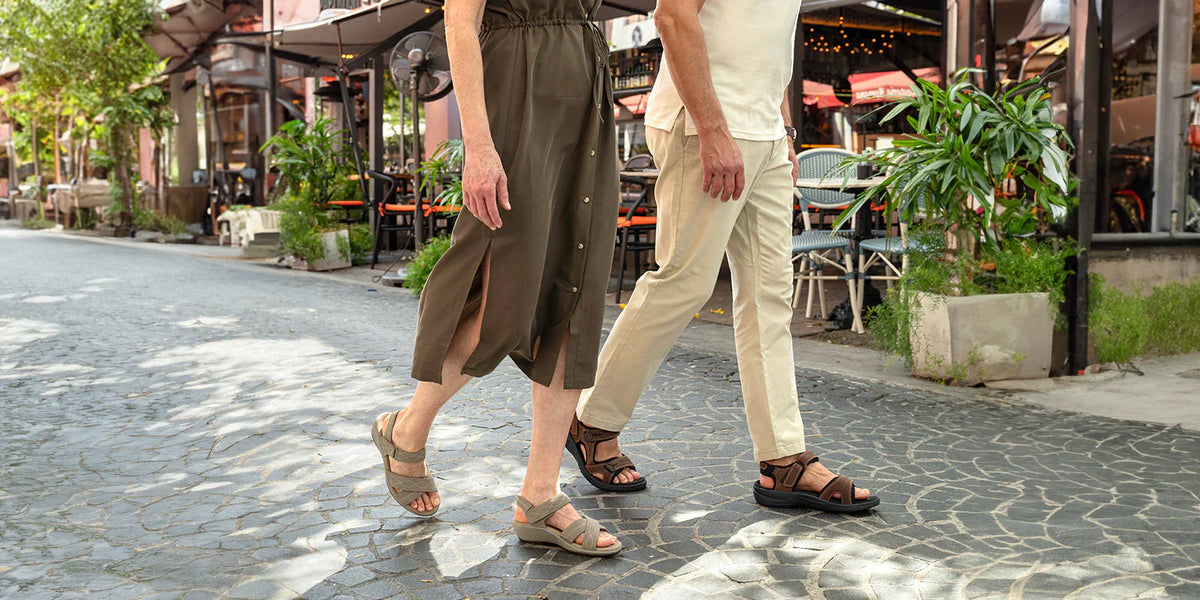The Orthofeet Blog
- All Posts
- All
- Arch Support
- Back Pain
- Bunion
- Diabetes
- Flat Feet
- Foot Pain
- Heel Pain
- Heel Spurs
- Hip Pain
- Knee Pain
- Plantar Fasciitis
- Swollen Feet

Vincent Lin / October 21, 2025
Can Stress Cause Burning Feet? Understanding the Connection
Can Stress Cause Burning Feet? Understanding the Connection
Read Post
Popular Articles
EXPERT CONTRIBUTORS
-
How Should Shoes Fit? A Complete Guide
Medical information provided by Orthofeet Team / June 06, 2025What happens when shoes don’t fit quite right? How should shoes fit? How can you tell if a shoe fits you properly? And what’s the right way to measure feet for the perfect fit? Read on to find all the answers and information you need to achieve your very own Cinderella or Cinderello shoe fit – prince or princess not included, and no fairy godmother needed... The basics of proper shoe fit When you ask 'how should shoes fit,' it might be helpful to understand why shoes should fit to begin with. Wearing the right size means not only daily comfort but also healthy feet. Even though the wrong fit can lead to all sorts of foot problems, one scientific review shows that between 63% and 72% of various study participants wear shoes that don’t actually fit either the width or the length of their feet [1]. Here’s what can happen when your shoes don’t fit properly: Foot problems and deformities – Shoes that are too tight or too loose can cause corns, calluses, and toe deformities like hammer toe [1][2]. People with diabetes are especially at risk, as tight walking or running shoes can make diabetic neuropathy worse, increasing the chance of wounds and ulcers [2]. Ingrown toenails – If your shoes squeeze your toes too much, your toenails might start growing into the skin, leading to pain, redness, and even infection [2]. Increased risk of falls – Wearing the wrong size shoes can affect your balance, making falls more likely, especially for older adults. In contrast, people wearing properly fitting shoes feel more stable and less afraid of falling [3]. Nerve problems – Tight shoes can put pressure on your nerves, leading to numbness, tingling, or even long-term nerve damage. Neuropathy affects many people dealing with diabetes, and the wrong shoes or sandals can make it even worse by further restricting blood flow, increasing the chance of wounds and ulcers [2]. The Orthofeet fit The answer to the question, 'How should shoes fit?' starts with giving your feet the space they need and Orthofeet shoes are designed to do just that. By designing orthopedic shoes with extra depth and a spacious toe box, your feet have room to move comfortably, allowing your toes to splay naturally. When your feet aren’t cramped in the footwear, they feel better and your balance improves. And if you’re wondering what to wear for sensitive feet or dealing with swelling, hammertoes, or bunions, the spacious toe box is a key design feature that helps manage your condition and significantly improve comfort. At the bottom, our built-in removable orthotic insoles let you adjust the fit and support with your own custom inserts if needed, or if you leave them in, the anatomical arch support and cushioning will help distribute pressure more evenly across the foot. In addition to a supportive fit, Our orthopedic shoes for women and orthopedic shoes for men use upper materials that offer a non-constricting fit, and breathable materials that help reduce moisture buildup and improve airflow to promote foot health. Whether it’s sneakers, running shoes, slippers, boots, work shoes, sandals, or dress shoes, our focus is on keeping your feet comfortable without compromising on style – all to ensure that every step feels as comfortable as possible. How to measure your feet correctly The first step in your ‘how should shoes fit’ journey and finding shoes that fit well is getting an accurate foot measurement. Since feet tend to swell throughout the day, it's best to measure them in the afternoon or evening when they're at their largest. Here are some tips to help you determine your shoe size and insole measurement. Step-by-step guide Prepare your materials – Before you start, you will need a sheet of paper, a pen, and a ruler or measuring tape. Stand on the paper – Place the paper on a flat surface and stand on it with your weight evenly distributed. Trace your foot – Hold a pen straight up and trace around your foot. For better accuracy, ask someone else to help with tracing if possible. This will help keep your sole flat on the ground and your weight evenly distributed. Measure the length – Use your ruler or measuring tape to measure the length from the tip of your longest toe to the back of your heel. Measure the width – Find the widest part of your foot and measure across it. Repeat for the other foot – One foot is often slightly larger than the other, so measure both and use the larger measurement to determine your shoe size. And here’s a tip: If your measurement falls between sizes, it’s usually best to round up for comfort. Wondering how to tell if you have wide feet? A common sign is feeling tightness on the sides of your shoes or pressure on your toes. If your pinky toe often feels squeezed or you notice red marks from your shoes at the end of the day, you might need wide width shoes. How much room should I have in my shoes? Signs that your shoes fit well Here’s what to look for in a good fit: Toe room A properly fitting shoe should have about a half-inch (or a thumb’s width) of space between your longest toe and the front of the shoe. This extra room allows your toes to move naturally without feeling cramped. If your shoes are too small, your toes will probably touch the ends of the shoes, causing discomfort, imbalance, and potential foot issues like bunions or hammertoes. On the other hand, if there's too much extra space, your foot might slide around, causing friction and blisters, and affecting your balance. A shoe that fits just right gives your toes enough room to splay naturally. Heel and ankle support When your shoes fit well, your heel should feel secure without slipping when you walk, but it shouldn’t feel too tight or restrictive. A good fit around the heel and ankle helps prevent rolling and instability, and minimize the risk of blisters and injuries like ankle sprains. If the heel slips or rubs, it could indicate that the shoe is too loose, and this rubbing may cause blisters and chafing. A snug but comfortable fit around the ankle area will help keep your foot properly aligned and make walking more comfortable. How much room should I have in my shoes in general? Another sign that your shoes fit well is the amount of space you feel in the shoe overall. You should be able to slip a finger between the back of your heel and the shoe, and your foot should feel secure and snug but not restricted in the width as well. Shoes that feel too tight or too loose are signs that you need to adjust the size. In other words, perfectly fitting shoes should feel snug in all the right areas: no pinching, no excessive slippage. They should be comfortable from the moment you put them on, with a bit of room for movement. It’s normal, though not always the case, for shoes to need a bit of breaking in, so don’t be alarmed by minor discomfort early on. But, if you’re still experiencing issues like blisters or pain after a few weeks of wear, it may be time to try shoes in a different size. Shoes that fit well from the beginning are key to preventing long-term foot problems and ensuring comfort with every step. Other aspects to consider when looking for a good fitting shoe Here are some important things to keep in mind when shopping for the perfect pair, beyond fit: Stability – Your foot should feel secure in the shoe. Make sure it doesn’t roll or twist easily, as stability helps prevent unnecessary strain on your feet and even injuries. Cushioning – Shoes with good cushioning help absorb the impact of each step when you’re walking or running. Make sure that both the internal and external materials provide the support your feet need to reduce pressure. Support – The shoe’s footbed should fit snugly against the soles of your feet. If it doesn’t, consider swapping the footbed for an orthotic or custom insole that helps your foot sit more comfortably in the shoe. For this reason, purchasing shoes that have a removable footbed is best. Timing for trying on new shoes – Since the foot swells throughout the day, it’s always best to try on new shoes in the evening when your feet are at their largest. Adjusting fit issues with insoles and inserts If you want to know how to make shoes more comfortable or have shoes that feel a little too tight or too loose, there are a few simple ways to make them work for you. As mentioned in the previous section, a good option is adding orthotic insoles to improve overall comfort and support. These insoles provide targeted arch support, cushion the feet, and can reduce pressure on sensitive spots. As a brand with a deep understanding of the different footwear needs, all our shoes are designed to offer plenty of room to accommodate inserts, whether custom or over the counter. Whether you need a little extra depth for foot conditions or are just looking for a better fit, our shoes are designed to make sure you can comfortably add your orthotics for a personalized fit. How to stretch shoes Many regular shoe brands don’t focus on features like wider widths and spacious toe boxes that can help with support. If you already have a pair of such shoes, or any other type of footwear that feels too tight but you aren’t ready to give them up, here are a few ways how to break in shoes and stretch them out: Use a shoe stretcher A shoe stretcher helps to stretch out tight spots by applying gentle pressure from within the shoe. It’s especially useful for making the toe box roomier or widening the shoe overall. Wear thick socks and apply heat Slip on a pair of thick socks, put your shoes on, and then use a hair dryer on the tight spots for a few minutes. The heat softens the material, and walking around while the shoes cool will help them stretch out. Consider the materials Leather shoes tend to respond well to heat, making them easier to stretch. For synthetic materials, using a shoe stretcher or the thick sock method may be more effective. Tips for buying shoes online Shopping online demands extra diligence to ensure the shoes you order will fit as intended. Consider these actionable tips: Accurate measurements - Follow your step-by-step guide and compare your results with the brand’s size chart. Read customer reviews - Look for feedback on fit, width, and comfort from verified buyers. Check return policies - Ensure that the seller offers a flexible return or exchange process in case the fit isn’t right. Research the brand’s sizing - Different brands can vary in fit—do a quick background check on their sizing standards and recommendations. Contact customer service - Don’t hesitate to ask for advice or clarification about specific models if you’re uncertain. Orthofeet’s size guide If you're unsure about your size, you can always use our size guide - it’s a handy tool to help you find the ideal pair based on your foot measurement and conditions. At Orthofeet, we go above and beyond by offering extended widths, extra depth, removable footbeds, and stretchable or non-restricting uppers. No matter your foot shape and size, you can find the shoes that fit you just right. [product-group-tile]============================ [1] Andrew K Buldt, Hylton Menz. Incorrectly Fitted Footwear, Foot Pain and Foot disorders: A Systematic Search and Narrative Review of the Literature. ResearchGate. December 2018. Accessed 24 February, 2025. https://www.researchgate.net/publication/326672847_Incorrectly_fitted_footwear_foot_pain_and_foot_disorders_A_systematic_search_and_narrative_review_of_the_literature [2] Terence Vanderheiden, DPM (Medically reviewed by Adam H. Kaplan, DPM). Why It's Important to Wear the Right Shoe Size. Very Well Health. October 14, 2022. Accessed 24 February, 2025. https://www.verywellhealth.com/do-people-wear-correct-size-shoes-1337769 [3] Tuba Maden PhD, Kezban Bayramlar Prof., Cagtay Maden PhD, Yavuz Yakut Prof. Investigating the Effects of Appropriate Fitting Footwear on Functional Performance Level, Balance and Fear of Falling in Older Adults: A Comparative-Observational Study. ScienceDirect. March 2021. Accessed 24 February, 2025. https://www.sciencedirect.com/science/article/abs/pii/S0197457221000021Read More -
Pain on Outside of Foot: Orthopedic Shoes for Lateral Foot Pain
Medical information provided by Orthofeet Team / June 06, 2025Explore the common causes and treatments for pain on the side of the foot. Learn how the right footwear can help manage and prevent outside foot pain.Read More





